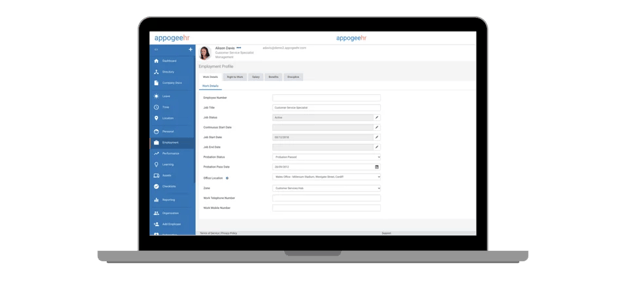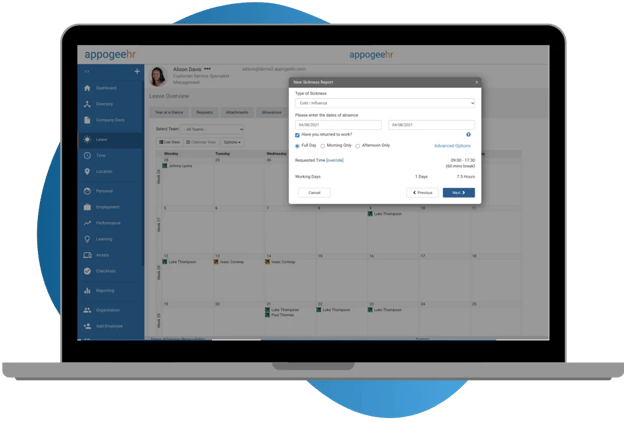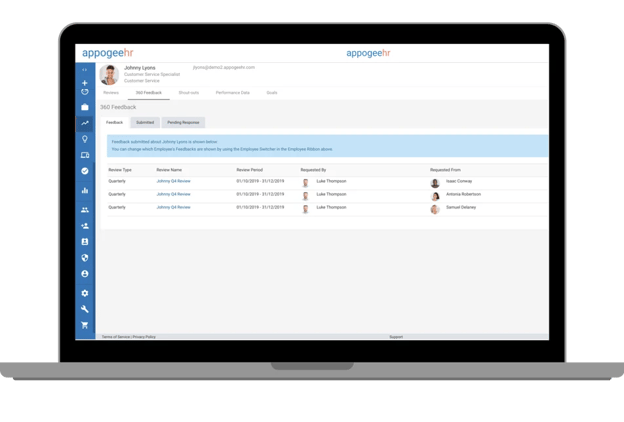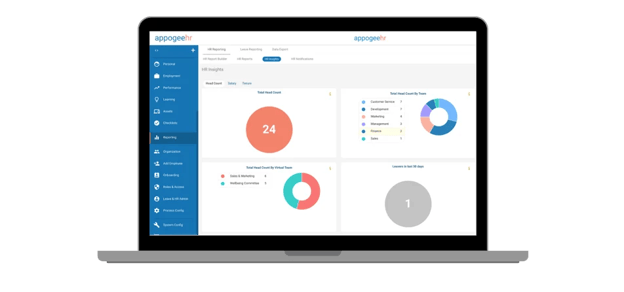7 tips for managing staff turnover in small businesses
Running a small business presents challenges. One day, you have to be an HR professional recruiting staff, and the next, a finance expert managing accounts. Add on top limited budgets, tight schedules, and the constant need to adapt to changing demands, and it's hardly surprising it can strain your resources.
Managing staff turnover is one of any organisation's most critical business functions. Since you can't make people stay working at your company, there are effective ways to manage staff turnover—diminishing recruitment costs and operational difficulties.
Since 60% of organisations[1] report talent is more difficult to retain than a year ago, small businesses must find ways to reduce the costs and effort tied to staff turnover.
This blog post will cover seven essential tips that you can implement now to efficiently manage employee turnover and minimise the impact on your resources.
The impact of staff turnover
Every business faces the challenge of retaining all its employees. While some workers commit for the long term, others might leave shortly after starting. Although hiring new employees has an immediate impact, consistent resignations over time can result in more severe and enduring consequences, such as:
- Increased costs. The financial impact of high staff turnover can lead to increased costs, including expenses related to recruitment, training, and onboarding of new employees. According to the CIPD[2], the cost of hiring senior managers is approximately £3,000, while for other employees, it is £1,500. Small businesses with constrained budgets may find coping with this financial pressure difficult.
- Operational disruption. Frequent turnover disrupts operational continuity. It may lead to knowledge transfer gaps, project timelines delays, and increased workloads on existing employees as they fill vacant positions.
- Low staff morale. Constant staffing changes can affect team dynamics and morale. Existing employees may feel demotivated or uncertain about the future, impacting overall team cohesion and productivity.
- Poor quality customer service. Small businesses usually maintain close relationships with clients or customers. High staff turnover can disrupt these relationships, as new employees may take time to get up to speed, potentially affecting the quality of service provided.
- Loss of institutional knowledge. When employees leave, they take valuable knowledge with them, which can harm small businesses that heavily depend on their expertise.
- Recruitment challenges. Small businesses may need help attracting and retaining skilled talent, leading to a cycle of continuous recruitment efforts. This process requires time and resources, diverting attention from other critical business activities.
- Productivity and training costs. Time spent on training new employees can impact overall productivity. Small businesses often operate with lean teams, and the need for extensive training can temporarily reduce efficiency.
1. Maintain effective communication
Poor communication can cause misunderstandings, delays, and errors in daily operations, disrupt workflow, and affect productivity. Additionally, unclear communication may lead to team conflicts and reduced morale, affecting the development of a cohesive and efficient team.
Let us illustrate.
Imagine a project where team members get unclear instructions about their roles. This leads to tasks overlapping or being ignored, causing frustration and conflicts about accountability and progress. The lack of clear communication becomes a challenge.
Secondly, poor communication can harm customer relationships and your small business's reputation, potentially leading to customer dissatisfaction and loss of business. For example, a small online retail business that fails to communicate effectively with its customers regarding shipping delays. Orders are delayed due to unforeseen circumstances, but the business neglects to inform customers promptly. As a result, customers are left in the dark about the status of their purchases. The negative feedback spreads, impacting their online reputation as prospective customers hesitate to purchase.
Thirdly, 45% of employees # say poor communication affects their trust in leadership and their team. For remote workers, this percentage increases to 54% for impact on trust in leadership and 52% for impact on trust in the team. This makes it challenging to build and maintain positive relationships.
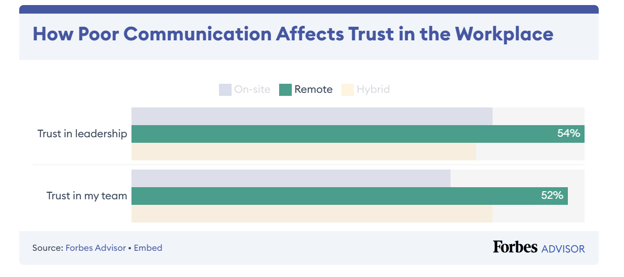
Source: Forbes
Improve communication within your small business by considering the unique needs of your employees and your business. Older employees might possess different technology skills than Millennials, and younger staff may prefer traditional communication methods such as face-to-face meetings or phone calls.
Clarity in communication helps employees stay informed and engaged. Ensure that there are clear and accessible communication channels. Use formal channels, such as regular team meetings, email updates, and project tracking software, and informal channels, like chat platforms or open-door policies.
Lastly, leverage technology to enhance communication efficiency. Appogee HR Success, for example, has a comprehensive range of collaboration and project management tools that facilitate seamless information sharing.
Self-service employee portals empower individuals to maintain their details, such as address and phone number. This can help reduce miscommunication and errors in storing sensitive information.
“The fact that our staff can update their own details and see their leave information has reduced the number of queries from employees and managers alike”
–Vicky Madigan, HR & Business Coordinator at SEM Energy Limited
2. Offer competitive compensation
Limited financial resources and economies of scale can pose staffing challenges for smaller businesses, hindering their ability to compete with larger corporations regarding salary and benefits. This difficulty in attracting and retaining top talent needs creative approaches to employee compensation that align with budget constraints.
Nonetheless, offering competitive compensation doesn’t have to start and end with a pay scale.
Incorporating supplementary benefits like private healthcare into your compensation package can significantly enhance its attractiveness, making employees healthier and happier. Additionally, offering private healthcare as part of your compensation can attract new hires and retain top talent, setting your small business apart and building a positive workplace.
Similarly, offering employee assistance programs (EAP), like counseling services and support networks, helps employees navigate personal and work challenges. This enhances their well-being, job satisfaction, and overall work environment, increasing their likelihood of staying with your company.
3. Provide training and development opportunities
With small businesses often facing changes in technology, market trends, and industry standards, training and development opportunities equip employees with the knowledge and skills to adapt and keep the business competitive.
Considering 93% of organisations[3] are concerned about employee retention, offering ongoing learning can help improve employee stability. This can improve employee skills but also show commitment to their growth. For instance, if you run a small tech business, training your staff on the latest software or digital marketing trends helps them adapt to technology changes. This improves their skills and keeps your business competitive–differentiating themselves by having employees with up-to-date skills and expertise.
Offer development opportunities and demonstrate a commitment to employees' professional growth. Organise in-house workshops, seminars, or training sessions where experienced staff members can support less skilled employees with how your small business operates, allowing for targeted and customised training that aligns with the specific needs of your business.
4. Maintain a healthy work/life balance
According to the CIPD[4], a quarter of UK employees struggle to meet personal commitments due to work demands. Although there's room for improvement, fostering a healthy work-life balance benefits your employees and your business. With 17.1 million working days[5] lost annually in the UK due to stress, depression, or anxiety, supporting employees in prioritising their health becomes essential.
There is overwhelming evidence nowadays that a balanced lifestyle improves mental and physical well-being. Employees with a good work-life balance are more focused and energised, boosting productivity and job satisfaction. Moreover, employees who feel their personal lives are respected are more likely to stay committed to their roles, reducing turnover rates.
HR software, such as leave and sickness management tools, aids employees in streamlined processes for requesting and managing time off. User-friendly platforms simplify leave requests and understanding of sickness records–allowing employees to take their leave quota to maintain a healthy work-life balance while ensuring efficient management of their time-off benefits.
Plus, this automation enhances the accuracy of leave tracking, saves you and your employees time, and ensures compliance with company policies, allowing for an organised and hassle-free experience.
Take it from Flora Oram, Head of People and Culture at Computeam, who says, “Both the leave and absence management tracking element and the HR profile are great. It’s so easy for employees to manage their leave requests. We came from a system that wasn’t suitable for term-time only or part-time workers, so this was one of the things that attracted us to Appogee HR.”
5. Hire the right people from the start
Employing suitable candidates is essential when starting or running a small business. Early hires significantly influence company culture, so selecting individuals who share your values and vision builds a positive and unified workplace, reducing the likelihood of turnover.
Although hiring your first recruits can feel invigorating, as each new team member plays a vital role in shaping your company's early journey, it is also an opportunity to bring on board individuals who not only possess the right skills but also share your passion and commitment to the business's mission.
As small businesses often face uncertainties and changes, hiring individuals who are adaptable and willing to take on various responsibilities will help your company navigate challenges more effectively. The right talent will also complement existing teams.
Take time to review candidate interview questions. Include conversations about values and work ethic and save costs associated with turnover and retraining. It's more cost-effective to invest in hiring individuals who are likely to stay and grow with the company rather than have to recruit new people repeatedly!
6. Consult and listen
If you've worked in an environment where the CEO or managers ignored your suggestions, you understand the frustration and demotivation this can cause. Feeling unheard can lead to disengagement and a lack of commitment, stifling creativity and the willingness to contribute ideas.
On the other hand, companies that listen to employees and actively welcome their ideas tend to have happier workers. Actively involving employees in decision-making processes and valuing their input enhances their sense of engagement and morale. So, when employees feel heard and respected, they are more likely to be motivated and committed to their work.
Likewise, employees often have valuable insights and great ideas to improve company processes, products, or services. For example, an employee who directly interacts with customers may suggest improvements to the customer service process based on their firsthand experiences.
Listen to your staff and regularly seek feedback. 360-degree feedback is a great way to gather insights into your staff members' progress.
Don't overlook the value of informal feedback opportunities. With fewer staff members, small businesses can more easily use informal channels, like conversations over the water cooler, during lunch, or team activities. Informal methods allow employees to share candid thoughts, concerns, and innovative ideas about their workplace culture.
7. Use data and analytics
Comprehensive HR data offers real-time insights into employee turnover, enabling targeted interventions. HR reporting tools help create, filter, and save meaningful reports, identifying trends and areas to improve employee retention, such as:
- Turnover rates. Get a comprehensive overview of the turnover rate within a specific time frame, helping HR professionals understand the frequency of employee departures.
- Exit interviews. Analysing data from exit interviews can help you identify common reasons for employee departures, allowing you to address potential issues and improve retention strategies.
- Demographic turnover. Break down turnover data based on employee demographics, such as age or department, and identify patterns to tailor retention efforts to specific groups.
- Cost of turnover. Calculate the financial impact of employee turnover, including recruitment costs, training expenses, and lost productivity.
- Retention program effectiveness. Assess the effectiveness of retention initiatives by tracking turnover rates before and after implementing specific programs or policies. This can help you make data-driven decision-making for future strategies.
Reduce staff turnover with Appogee HR Success
Small businesses often face financial constraints, limiting their ability to invest in employee benefits, advanced technology, or extensive retention programs.
Despite these challenges, addressing staff turnover is possible. It requires understanding employee needs, open communication, attractive benefits, and the use of HR technology.
With the proper knowledge and practical tools, you can minimise employee turnover, creating a more stable and engaged workforce. This boosts workplace morale and enhances long-term business success by retaining valuable talent.
Appogee HR Success can help you manage staff turnover with ease. We have a range of pricing and package options to suit your small business. Alternatively, why not try Appogee HR, free for 14 days?
Sources
[1] CIPD
[2] CIPD
[3] LinkedIn 2023 Workplace Learning Report
[4] CIPD: Good Work Index 2023: Summary report
[5] HSE
[6] BMC Medicine
.webp?height=168&name=appogeehr%20(1).webp)


